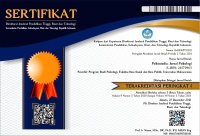Urutan Kelahiran dan Bullying
Abstract
Bullying between students that occurs in schools is a very worrying phenomenon for psychologists, teachers and families in many countries including Indonesia. This study aims to find out differences in bullying behavior in adolescents in terms of birth order. According to Adler, birth order and interactions within the family are related to a variety of psychological and social factors. The research subjects were 96 adolescents who had birth order as the eldest child, middle child, youngest child and only child, using purposive sampling technique. The scale used is adolescent peer relations from Parada, to measure the frequency of bullying. The data analysis technique used the Mann Whitney u-test. The results showed that there was no difference in the average bullying behavior of the eldest child and middle child (sig 0.341 < 0.05), the eldest child and youngest child (sig 0.277 < 0.05), the eldest child and only child (sig 0.330). < 0.05), middle child with youngest child (sig 0.077 < 0.05), youngest child with only child (sig 0.901 < 0.05). Meanwhile, in middle and only children, there was a difference in average bullying behavior (sig 0.043 < 0.05). The results of this study can be used as a basis for designing bullying prevention programs based on birth order.
Bullying antarsiswa yang terjadi di sekolah merupakan fenomena yang sangat mengkhawatirkan psikolog, guru dan keluarga di banyak negara termasuk di Indonesia. Penelitian ini bertujuan untuk mengetahui perbedaan perilaku bullying pada remaja ditinjau dari urutan kelahiran. Menurut Adler, urutan kelahiran dan interaksi dalam keluarga berkaitan dengan berbagai faktor psikologis dan sosial. Subjek penelitian berjumlah 96 remaja yang memiliki urutan kelahiran sebagai anak sulung, anak tengah, anak bungsu dan anak tunggal, dengan menggunakan teknik purposive sampling. Skala yang digunakan adalah adolescent peer relation dari Parada, untuk mengukur frekuensi bullying. Teknik analisis data menggunakan mann whitney u-test. Hasil penelitian menunjukkan bahwa tidak ada perbedaan rata-rata perilaku bullying pada remaja anak sulung dengan anak tengah (sig 0,341 < 0,05), anak sulung dengan anak bungsu (sig 0,277 < 0,05), anak sulung dengan anak tunggal (sig 0,330 < 0,05), anak tengah dengan anak bungsu (sig 0,077 < 0,05), anak bungsu dengan anak tunggal (sig 0,901 < 0,05). Sedangkan pada remaja anak tengah dan anak tunggal, terdapat perbedaan rata-rata perilaku bullying (sig 0,043 < 0,05). Hasil penelitian ini dapat dijadikan dasar perancangan program prevensi bullying berdasarkan urutan kelahiran
Keywords
Full Text:
FULL TEXTReferences
Abid, M., Irfan, M., & Naeem, F. (2017). RELATIONSHIP BETWEEN MINDFULNESS AND BULLYING BEHAVIOR AMONG SCHOOL CHILDREN: AN EXPLORATORY STUDY FROM PAKISTAN. Journal of Postgraduate Medical Institute, 31(3). https://jpmi.org.pk/index.php/jpmi/article/view/2050
Adler, A. (2011). Social Interest: A Challenge to Mankind. Martino Publishing.
Altonji, J. G., Cattan, S., & Ware, I. (2017). Identifying Sibling Influence on Teenage Substance Use. Journal of Human Resources, 52(1), 1–47. https://doi.org/10.3368/jhr.52.1.0714-6474R1
ARGYS, L. M., REES, D. I., AVERETT, S. L., & WITOONCHART, B. (2006). BIRTH ORDER AND RISKY ADOLESCENT BEHAVIOR. Economic Inquiry, 44(2), 215–233. https://doi.org/10.1093/ei/cbj011
Arya, L., & Syanti, W. R. (2022). Bullying pada Remaja: Pentingkah Keberfungsian Keluarga, Kebahagiaan di Sekolah, dan Self-Esteem? Jurnal Ilmu Perilaku, 5(2), 193. https://doi.org/10.25077/jip.5.2.193-207.2021
Book, A. S., Volk, A. A., & Hosker, A. (2012). Adolescent bullying and personality: An adaptive approach. Personality and Individual Differences, 52(2), 218–223. https://doi.org/10.1016/j.paid.2011.10.028
Bowes, L., Wolke, D., Joinson, C., Lereya, S. T., & Lewis, G. (2014). Sibling Bullying and Risk of Depression, Anxiety, and Self-Harm: A Prospective Cohort Study. Pediatrics, 134(4), e1032–e1039. https://doi.org/10.1542/peds.2014-0832
Copeland, W. E., Wolke, D., Angold, A., & Costello, E. J. (2013). Adult Psychiatric Outcomes of Bullying and Being Bullied by Peers in Childhood and Adolescence. JAMA Psychiatry, 70(4), 419. https://doi.org/10.1001/jamapsychiatry.2013.504
Coşkun, K., Çikrikci, Ö., & Topkaya, Y. (2017). Is birth order really important in peer relationship? A grounded theory approach. Cogent Education, 4(1), 1296537. https://doi.org/10.1080/2331186X.2017.1296537
DOGRU CABUKER, N., EPLI, H., BALCI CELIK, S., & VURAL, M. (2020). Does Psychological Birth Order Predict Identity Perceptions of Individuals in Emerging Adulthood? International Online Journal of Educational Sciences, 12(5). https://doi.org/10.15345/iojes.2020.05.012
Elgar, F. J., Craig, W., & Trites, S. J. (2013). Family Dinners, Communication, and Mental Health in Canadian Adolescents. Journal of Adolescent Health, 52(4), 433–438. https://doi.org/10.1016/j.jadohealth.2012.07.012
Esser, F., & Vliegenthart, R. (2017). Comparative Research Methods. In The International Encyclopedia of Communication Research Methods (pp. 1–22). Wiley. https://doi.org/10.1002/9781118901731.iecrm0035
Ewen B, R., & Ewen, R. B. (2014). An Introduction to Theories of Personality. Psychology Press. https://doi.org/10.4324/9781315793177
Fanti, K. A., & Henrich, C. C. (2015). Effects of Self-Esteem and Narcissism on Bullying and Victimization During Early Adolescence. The Journal of Early Adolescence, 35(1), 5–29. https://doi.org/10.1177/0272431613519498
Farrell, A. H., Schiralli, K. N., & Volk, A. A. (2017). Factors That Influence Bullying. In Encyclopedia of Evolutionary Psychological Science (pp. 1–5). Springer International Publishing. https://doi.org/10.1007/978-3-319-16999-6_162-1
Farrell, A. H., Schiralli, K. N., & Volk, A. A. (2021). Factors That Influence Bullying. In Encyclopedia of Evolutionary Psychological Science (pp. 2909–2913). Springer International Publishing. https://doi.org/10.1007/978-3-319-19650-3_162
Fatima, Z., & Ashraf, R. (2018). Psychological Birth Order, Self-Efficacy and Achivement Motivation in Students. European Journal of Research in Social Sciences, 6(6), 25–39.
Franklin, J. C., Ribeiro, J. D., Fox, K. R., Bentley, K. H., Kleiman, E. M., Huang, X., Musacchio, K. M., Jaroszewski, A. C., Chang, B. P., & Nock, M. K. (2017). Risk factors for suicidal thoughts and behaviors: A meta-analysis of 50 years of research. Psychological Bulletin, 143(2), 187–232. https://doi.org/10.1037/bul0000084
Grinberg, A. (2015). The Effect of Birth Order on Occupational Choice. Atlantic Economic Journal, 43(4), 463–476. https://doi.org/10.1007/s11293-015-9474-2
Holt, M. K., Vivolo-Kantor, A. M., Polanin, J. R., Holland, K. M., DeGue, S., Matjasko, J. L., Wolfe, M., & Reid, G. (2015). Bullying and Suicidal Ideation and Behaviors: A Meta-Analysis. Pediatrics, 135(2), e496–e509. https://doi.org/10.1542/peds.2014-1864
Hong, J. S., & Espelage, D. L. (2012). A review of research on bullying and peer victimization in school: An ecological system analysis. Aggression and Violent Behavior, 17(4), 311–322. https://doi.org/10.1016/j.avb.2012.03.003
Iswinarti, & Khairunnisa, H. (2021). Enhancing self-esteem using child-centred play therapy on bullying victims children. AMCA JOURNAL OF EDUCATION AND BEHAVIORAL CHANGE, 1(2), 37–43.
Kammeyer, K. (1967). Birth Order As a Research Variable. Social Forces, 46(1), 71. https://doi.org/10.2307/2575323
Katsaras, G. N., Vouloumanou, E. K., Kourlaba, G., Kyritsi, E., Evagelou, E., & Bakoula, C. (2018). Bullying and Suicidality in Children and Adolescents Without Predisposing Factors: A Systematic Review and Meta-analysis. Adolescent Research Review, 3(2), 193–217. https://doi.org/10.1007/s40894-018-0081-8
Kaul, A., & Srivastava, A. (2018). Birth order and personality. Indian Journal of Health and Well-Being, 9(3), 377–379.
Kim, Y. S., Leventhal, B. L., Koh, Y.-J., & Boyce, W. T. (2009). Bullying Increased Suicide Risk: Prospective Study of Korean Adolescents. Archives of Suicide Research, 13(1), 15–30. https://doi.org/10.1080/13811110802572098
Lehmann, J.-Y. K., Nuevo-Chiquero, A., & Vidal-Fernandez, M. (2018). The Early Origins of Birth Order Differences in Children’s Outcomes and Parental Behavior. Journal of Human Resources, 53(1), 123–156. https://doi.org/10.3368/jhr.53.1.0816-8177
Lereya, S. T., Copeland, W. E., Costello, E. J., & Wolke, D. (2015). Adult mental health consequences of peer bullying and maltreatment in childhood: two cohorts in two countries. The Lancet Psychiatry, 2(6), 524–531. https://doi.org/10.1016/S2215-0366(15)00165-0
Liu, X., Huang, Y., & Liu, Y. (2018). Prevalence, distribution, and associated factors of suicide attempts in young adolescents: School-based data from 40 low-income and middle-income countries. PLOS ONE, 13(12), e0207823. https://doi.org/10.1371/journal.pone.0207823
Mairet, P. (2013). Alfred Adler: Problems of Neurosis. Routledge. https://doi.org/10.4324/9781315010250
McHale, S. M., Updegraff, K. A., & Whiteman, S. D. (2012). Sibling Relationships and Influences in Childhood and Adolescence. Journal of Marriage and Family, 74(5), 913–930. https://doi.org/10.1111/j.1741-3737.2012.01011.x
Oberst, U. E., & Stewart, A. E. (2014). Adlerian Psychotherapy. Routledge. https://doi.org/10.4324/9781315820262
OECD. (2017). PISA 2015 Results (Volume III). OECD. https://doi.org/10.1787/9789264273856-en
OECD. (2018). Teaching for the Future. OECD. https://doi.org/10.1787/9789264293243-en
Pratiwi, M. P., Fitriani, N., & Setiyadi, I. (2021). Hubungan kejadian bullying dengan self-esteem (harga diri) dan resiliensi pada remaja . Alauddin Scientific Journal of Nursing, 2(1), 10–18.
Rohrer, J. M., Egloff, B., & Schmukle, S. C. (2015). Examining the effects of birth order on personality. Proceedings of the National Academy of Sciences, 112(46), 14224–14229. https://doi.org/10.1073/pnas.1506451112
Sapouna, M., & Wolke, D. (2013). Resilience to bullying victimization: The role of individual, family and peer characteristics. Child Abuse & Neglect, 37(11), 997–1006. https://doi.org/10.1016/j.chiabu.2013.05.009
Schultz, D. P., & Schultz, S. E. (2014). Teori Kepribadian. Buku Kedokteran EGC.
Steelman, L. C., & Powell, B. (1985). The Social and Academic Consequences of Birth Order: Real, Artifactual, or Both? Journal of Marriage and the Family, 47(1), 117. https://doi.org/10.2307/352073
Steelman, L. C., Powell, B., Werum, R., & Carter, S. (2002). Reconsidering the Effects of Sibling Configuration: Recent Advances and Challenges. Annual Review of Sociology, 28(1), 243–269. https://doi.org/10.1146/annurev.soc.28.111301.093304
Tippett, N., & Wolke, D. (2015). Aggression between siblings: Associations with the home environment and peer bullying. Aggressive Behavior, 41(1), 14–24. https://doi.org/10.1002/ab.21557
Toseeb, U., McChesney, G., Dantchev, S., & Wolke, D. (2020). Precursors of sibling bullying in middle childhood: Evidence from a UK-based longitudinal cohort study. Child Abuse & Neglect, 108, 104633. https://doi.org/10.1016/j.chiabu.2020.104633
Ttofi, M. M., & Farrington, D. P. (2012). Bullying prevention programs: the importance of peer intervention, disciplinary methods and age variations. Journal of Experimental Criminology, 8(4), 443–462. https://doi.org/10.1007/s11292-012-9161-0
Ttofi, M. M., Farrington, D. P., Lösel, F., Crago, R. v., & Theodorakis, N. (2016). School bullying and drug use later in life: A meta-analytic investigation. School Psychology Quarterly, 31(1), 8–27. https://doi.org/10.1037/spq0000120
Valkov, P. (2018). Birth order and its relatedness to substance use disorder : an empirical research in Bulgaria. International Journal of Emotional Education, 10(2), 154-158.
Volk, A. A., Farrell, A. H., Franklin, P., Mularczyk, K. P., & Provenzano, D. A. (2016). Adolescent Bullying in Schools: An Evolutionary Perspective (pp. 167–191). https://doi.org/10.1007/978-3-319-29986-0_7
Volk, A. A., Provenzano, D. A., Farrell, A. H., Dane, A. v., & Shulman, E. P. (2021). Personality and bullying: Pathways to adolescent social dominance. Current Psychology, 40(5), 2415–2426. https://doi.org/10.1007/s12144-019-00182-4
Wolke, D., Copeland, W. E., Angold, A., & Costello, E. J. (2013a). Impact of Bullying in Childhood on Adult Health, Wealth, Crime, and Social Outcomes. Psychological Science, 24(10), 1958–1970. https://doi.org/10.1177/0956797613481608
Wolke, D., Copeland, W. E., Angold, A., & Costello, E. J. (2013b). Impact of Bullying in Childhood on Adult Health, Wealth, Crime, and Social Outcomes. Psychological Science, 24(10), 1958–1970. https://doi.org/10.1177/0956797613481608
Wolke, D., Tippett, N., & Dantchev, S. (2015). Bullying in the family: sibling bullying. The Lancet Psychiatry, 2(10), 917–929. https://doi.org/10.1016/S2215-0366(15)00262-X
DOI: http://dx.doi.org/10.30872/psikostudia.v11i4.8809
Refbacks
- There are currently no refbacks.
Copyright (c) 2022 Psikostudia : Jurnal Psikologi

This work is licensed under a Creative Commons Attribution-ShareAlike 4.0 International License.
Psikostudia: Jurnal Psikologi is indexed by :
PSIKOSTUDIA: Jurnal Psikologi Published by Faculty of Social and Political Siences, University of Mulawarman, Samarinda, East Kalimantan and This work is licensed under a Creative Commons Attribution-ShareAlike 4.0 International License.
_________________________________________
PSIKOSTUDIA: Jurnal Psikologi
Department of Psychology
Faculty of Social and Political Siences, University of Mulawarman
Jl. Muara Muntai Kampus Gn. Kelua Samarinda 75411
Phone: +62 813 35350368
E-Mail: psikostudia@fisip.unmul.ac.id




















